SPOTTER'S GUIDE
Whilst the photo features elsewhere on this site look at individual vehicles in detail, this page seeks to draw comparisons between the various Mks. The aim is to provide a few quick pointers on how to identify Churchills and what features are of interest. Bear in mind that many surviving vehicles are no longer complete or composite restorations.
For convenience we'll first divide up Churchill series into four basic vehicle types upon which the many different Mks were based.
| A22 | A22F | ||
|
MkI
|
MkIII
|
MkIV
|
MkVII
|
There were or course many other variants, especially with regard to specialised engineering vehicles, but those listed above are those that saw service in any number. Throughout Churchill production there was a continuous rework scheme that resulted in some of the earlier MkI and II tanks being upgraded to III and IVs. As the new MkVII was introduced the MkIII and IV tanks were upgunned or converted to AVRE or close support (95mm howitzer) tanks.
A22F - MkVII, MkVII Crocodile, MkVII AVRE, MkVIII, MkVIII Crocodile
We'll start with the later variants because these are by far the most common survivors. The later Churchills were all based upon the MkVII A22F ‘Heavy Churchill’ and are easily distinguished by their round side hatches, round driver's vision ports and round Besa mount. So the rule of thumb is 'if a hull has round apertures then it's a later Mk of Churchill'. The MkVII turret is also quite distinct in shape from the earlier Mks, often be equipped with the all round vision cupola and twin element sighting vane.

The majority of the later MkVII turrets have bulges either side of the Gun mantlet although not all. OK, so assuming we've found a hull with round apertures what else should we consider? Well the options are that we either have a MkVII, MkVII Crocodile, MkVII AVRE, MkVIII or possibly a MkVIII Crocodile.
Crocodiles can only be distinguished from their hull fittings - the flame projector at the front, trailer linkage at the back or armoured fuel conduit under the belly


The majority of Crocodiles were MkVII although there is a MkVIII Crocodile at Puckapunyal and the Australians apparently ordered a a high percentage of MkVIIIs which were intended to be converted to Crocodiles. MkVIIIs are most easily identified by the 95mm gun (see MkV below) or if this is absent by the shape of the gun mantlet aperture which is different from that of the MkVII or MkVII AVRE. Other more subtle differences are that the rear right hand corner of the turret includes an additional narrow face and there is a prominent casting seem about two thirds up the turret all the way round above which the front face angles inwards slightly.
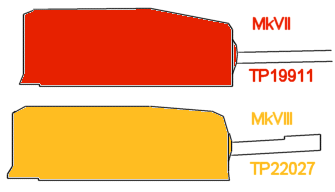
The differences in shape and size between the MkVII and VIII turrets are illustrated above. The TP number is the part number for the casting and is often found cast onto one of the turret faces.
MkVII AVREs, if complete, are easily identified by the 165mm howitzer and dozer blade.


However, even if these are not present the shape of the mantlet, attachment points for the dozer, and turret attachment points for smoke launchers are potential giveaways.
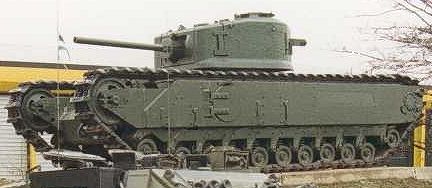
The vehicle above has been 'restored' to resemble a gun tank but the mantlet shape, bevel around the mantlet where a cover would have been attached, "I" shaped smoke launcher brackets and dozer attachment points on the hull sides indicate that this was once an AVRE.
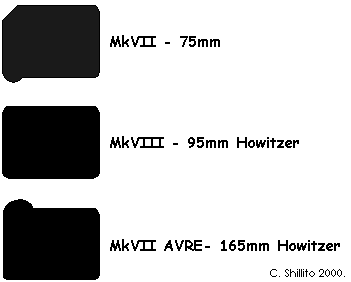 |
|
Mantlet Apertures. |
A22 Hulls
All Mks prior to the MkVII has similar hulls with rectangular side access door, driver's vision block and Besa aperture.


Note the cone shaped hull bolts on the picture to the left. The A22 hulls were constructed by bolting and riveting unlike the A22F which was all welded. Initially the hull bolts were slightly recessed however as part of the MkIII/MkIV rework process these were subsequently replaced with longer bolts which either had cone shaped covers or cone shape nuts.


The cone type would seem to indicate a very early reworked hulls. If these protruding bolts are not present then you are either looking at an early un-reworked MkIII hull (which must be unlikely) or a MkI or MkII. The three bolts behind the side door are arranged differently on each side of the hull - on the right hand side the arrangement is a horizontal mirror image of that shown above with two on the bottom and one on the top.
AVRE hulls (although not which Mk) can be recognised by the sliding hatch over the co-driver's position which replaces the usual 2 part hatch.
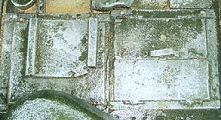
A22 MkIV Variants
The MkIV turret itself is entirely cast and as a consequence is of a rounded appearance. The spigot mortar of the AVRE is easily identifiable (if present) as is the 95mm howitzer of the Mk V.
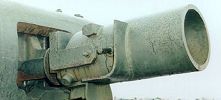

Spotting the difference between a MkIV (75mm) and a MkVI is no easy task. The MkIV (75mm) was a standard MkIV rearmed with a 75mm gun whereas a MkVI was a MkVI reworked as far as possible to MkVII standards (which also meant the 75mm gun). The majority of the differences would seem to be internal but in general the MkVI will have an all round vision cupola and a two element sighting vane.
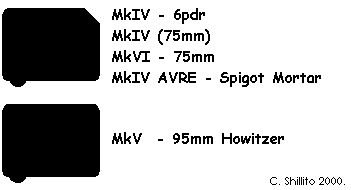 |
|
Mantlet Apertures. |
A22 MkIII Variants
There are no uniquely distinguishing hull features that can identify a MkIII from a MkIV. All differences are concerned with the turret, which in this case, is welded and consequently slab sided.

The mantlets of the MkIII variants are all the same but if present the armament of each type is quite identifiable. As with the MkIV, AVRE hulls can be distinguished by the sliding hatch over the co-driver's position and the hull side attachment points for the various engineering tools.
 |
|
Mantlet Apertures. |
A22 MkI & MkII
Surviving early Mks of Churchill are rare as the majority were either reworked into later models or retained for training purposes and most likely ended up as range targets. The hulls are pretty much identical to the MkIII/IV however the MkI was armed with a hull mounted 3" howitzer rather than the Besa machine gun of all later models. The howitzer mount was provided with two separate apertures in the hull front, one for the howitzer and one for the telescopic sight.

Compare the above with the photograph below which is MkII 'pretending to be a MkI.

The MkI and MkII had a different pattern of air intake from the subsequent Mks being cast and with the intake itself pointing downwards rather than upwards (every early MkIIIs also had the earlier pattern intake)
The turrets of MkI and MkII are identical and are much smaller than any other Mk being armed with the 2-pdr. Rather than one large mantlet aperture as on the later tanks, the MkI and MkII have three separate apertures for the coaxial Besa, 2-pdr, and telescopic sight. The turrets themselves are cast and of a geometrically complex and asymmetric shape.
